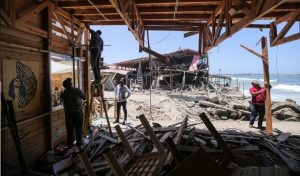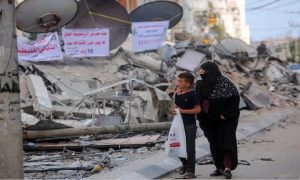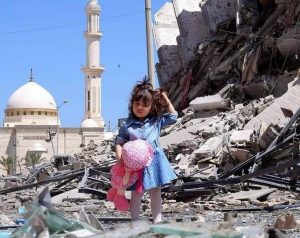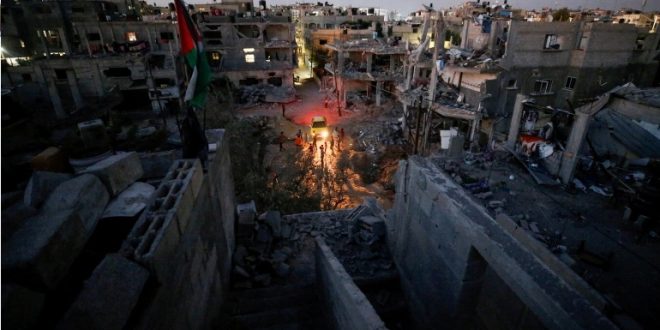26-05-2021
GAZA CITY: Suzan Matar watched the building that housed her eight-year-old business crumble live on television.
It was one of the several landmark structures targeted by Israeli fighter jets during its 11-day assault on the besieged Gaza Strip.
The nine-floor al-Johara Tower in the heart of Gaza City was struck by several missiles on May 12. It housed Matar’s law firm, which was previously an apartment owned by her father.
The 34-year-old was at home watching the news when she found out the building was targeted.
“Finding out this way consumed me. I felt helpless,” Matar told media, crying. “I couldn’t stop it. I couldn’t tell them, please just leave my office alone; please don’t do anything to harm it. It was my baby.”
 Starting her business was a “lifelong dream”. On a regular day, Matar and her colleagues would spend up to 12 hours in the office that she described as a “second home”.
Starting her business was a “lifelong dream”. On a regular day, Matar and her colleagues would spend up to 12 hours in the office that she described as a “second home”.
She had many of her personal belongings in the office, including several awards, pictures of her late fiance and gifts from her friends.
All of that was destroyed in a blink of an eye. But what remained, she said, are “endless memories engraved in my heart”.
Matar knows rebuilding her business will not be easy. Like many others, she wonders how so much will be brought back while Gaza remains under siege. More importantly, she asks, who will pay for all the damage.
‘Livelihoods gone’
Israel’s bombardment killed 253 Palestinians, including 66 children. Wreckage and rubble surround makeshift camps across Gaza, which has been under a crippling siege since 2007.
The attacks also destroyed 1,800 residential units that are now unfit for housing, and partially destroyed at least another 14,300 housing units, forcing tens of thousands of Palestinians to take shelter in United Nations-run schools.
 Some 74 public buildings, including local municipalities, were also destroyed, according to figures released by the information ministry run by Hamas, the group that governs the Gaza Strip.
Some 74 public buildings, including local municipalities, were also destroyed, according to figures released by the information ministry run by Hamas, the group that governs the Gaza Strip.
Since the announcement of the ceasefire, homeowners, shopkeepers and businesses have been assessing damages incurred and examining what has been left of their lives.
Tamer Baker, 27, stood in his partially damaged restaurant as he recalled how he made it out alive.
On May 10, it was targeted by an air strike, demolishing more than half of it. Baker rushed out when he received a warning, moments before it was hit.
“I have no idea how I will ever be compensated,” Baker told media. “I can’t afford rebuilding it, given the extent of the damage.”
The restaurant, opened in August last year, was one of the few in western Gaza that overlooked the Mediterranean.
In September, it was shut for three months due to coronavirus-related restrictions.
“More than 50 people worked here. They had families. Now, their livelihood is gone,” Baker said.
 Last week, Palestinian officials said it would cost around $150m to rebuild the damage to industry, power and agriculture in the already impoverished enclave.
Last week, Palestinian officials said it would cost around $150m to rebuild the damage to industry, power and agriculture in the already impoverished enclave.
While the UN’s Central Emergency Response Fund said it released $18.5m for humanitarian efforts, several countries have promised to pour in millions of dollars in aid.
‘Major obstacles’
On Tuesday, Israel finally allowed the opening of the Karam Abu Salem (Kerem Shalom in Hebrew) crossing for some of the aid to go through.
The crossing is the main passageway that transfers necessities to Gaza’s nearly two million residents, and is one of two passageways controlled by Israel.
The third, the Rafah crossing, is controlled by neighboring Egypt.
Israel’s siege of Gaza has also stopped the flow of construction materials needed to rebuild much of the enclave’s infrastructure, which was damaged in the previous Israeli military campaigns of 2008, 2012 and 2014. (Int’l Monitoring Desk)
 Pressmediaofindia
Pressmediaofindia




